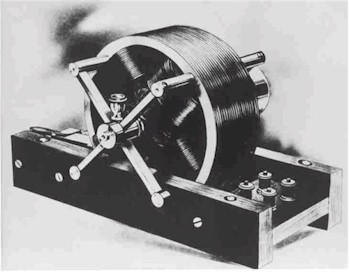
The following paragraphs comprise a biography of Nikola Tesla and a description of his scientific achievements, with emphasis on those which pertain to his work at Wardenclyffe. You can read the article in its entirety or click on one of the key words below to jump to that section.
KEY WORDS
Nikola Tesla, one of America's greatest electrical and mechanical engineers, was born in Smiljan, Croatia on July 10, 1856. He attended the Austrian Polytechnic School in Graz and the University of Prague and first worked as an engineer for the Yugoslavian government, assisting with installation of that country's very first telephone system. In 1883, Tesla worked for one year at Thomas Edison's European subsidiary in Paris, after which he traveled to New York where he worked for Edison directly.
Tesla's entire adult life was dedicated to the task of designing and improving devices for, as he put it, "the service of mankind." During Dr. Tesla's long career he invented many things that truly changed the way in which we all live, and literally made possible the tremendous productivity of American industry in the twentieth century.
Tesla's first major contribution to society was in the area of electrical power utilization. The advantages that alternating currents held in their ease of generation and transmission were readily apparent. The major obstacle that lay in the path to the use of alternating current on a large scale, however, was the absence of a practical AC electric motor.

One of the original two-phase induction motors. It was demonstrated by Tesla in his historic lecture of May 16, 1888, before the American Institute of Electrical Engineers at Columbia University. This motor, together with Tesla's polyphase system for the generation, transmission, and distribution of electric power became the foundation of the electric power industry. The motor developed 1/5 horsepower and showed the commutator and brushes could be dispensed with. [EM002 2-Phase Motor]
In 1882 Tesla, who had realized that AC held the key to an efficient power distribution system, successfully designed the needed motor. His demonstration of a 1/5 horsepower two-phase motor at Columbia University on May 16, 1888, before the American Institute of Electrical Engineers, helped to usher in a new era of inexpensive and abundant electrical energy.
By 1892 the U.S. Patent office had issued Tesla over 40 patents based upon his rotating magnetic field principal, covering what is known as the Polyphase Power System. By mid 1895 the world's first commercial hydroelectric AC power plant was in operation at Niagara Falls, New York. The nameplates on the massive generators that were installed there bore Tesla's name. To this day, virtually every single electric induction motor in use around the world is based upon one of Tesla's original designs.
Of course Tesla polyphase or three-phase AC power is only one of the contributions that this little known and seldom recognized inventor gave to the world. The public at large is only now becoming aware of the fact that Nikola Tesla also originated and built all of the basic circuits required for the transmission and reception of wireless communications—what we now call radio and broadcast television.
The fact that he is the inventor of radio was acknowledged by the United States Supreme Court in 1943 when he was posthumously acknowledged as having priority over Guglielmo Marconi in regards to the fundamental radio patents.
Tesla first demonstrated radio transmission and reception in 1893, two years before Marconi, and operated a radio controlled boat at Madison Square Garden in 1898. He knew that in addition to Morse code and remote control, the sound of a human voice, music, and even visual images could also be transmitted with his system.
A somewhat interesting note is that devices he designed for producing high voltages eventually evolved into the high voltage power supplies which operate our present day television cathode ray picture tubes.
In the spring of 1899, shortly after receiving an informal request from an office of the U.S. Government to develop a wireless communications system, Tesla moved his work to a high plateau near Colorado Springs. There he constructed a large experimental radio station unlike anything the world had ever seen before. His plan was to study the characteristics of high voltage, high frequency alternating electrical currents with the intellectual goal of ascertaining "the laws of propagation of currents through the earth and the atmosphere." His first task was to develop an extremely powerful transmitter and perfect a method by which the transmitted energy could be channelized or using his word "individualized." At the same time he developed a number of sophisticated receivers "for individualizing and isolating the energy transmitted" that would allow a transmitter's signals to be selectively tuned in. What followed was a series of important experiments that vastly increased man's knowledge of radio propagation and earth resonance, culminating nearly a decade of work related to the study of synchronized electrical tuned circuits.
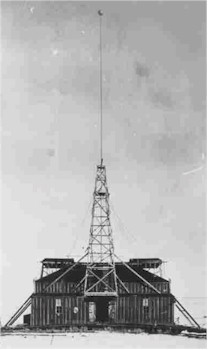
A front view of the Colorado Springs laboratory with sign over doorway reading in Latin "Lisciate ogni speranza, voi ch'entrate!" freely translated "Abandon all hope, ye who enter here." [CS010 Front View]
The successes that he achieved in Colorado led to Tesla's absolute conviction that wireless communication to any point on the globe was possible by the help of devices he had perfected, and set the stage for Tesla's next grand feat—establishment of an international wireless telecommunications and broadcasting facility that was to become known as Wardenclyffe.
In December of 1900, after wrapping up his preliminary testing he returned to New York to begin work on the full sized prototype worldwide broadcasting station.
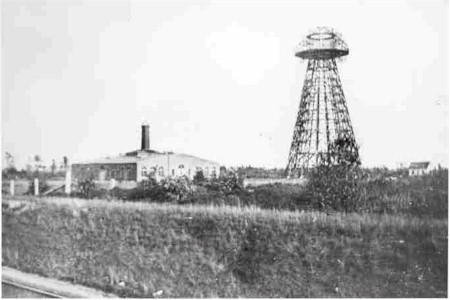
Tesla's Wardenclyffe plant and wireless telecommunications tower at Shoreham, Long Island, New York. This photograph was taken from the local Long Island Rail Road station in 1914. [WP008]
The main structure built to house equipment for this station and known as the Wardenclyffe Laboratory Building, is still standing near the Long Island community of Shoreham, New York. Not a great amount has been learned about the station's specific design details. It is quite certain that there would have been major similarities between it and the large 1899 apparatus in Colorado. Tesla's investigations at Wardenclyffe were brought to an end due to a lack of research funding. The building was abandoned and Tesla's tower was eventually demolished during the early years of World War I.
One interesting feature of Tesla's world system for global communications, had it gone into full operation, would have been its capacity to demonstrate on a limited scale the wireless transmission of electrical power. If the prototype communications station at Wardenclyffe had shown the feasibility of wireless power transmission, then Tesla intended to build a full scale power transmitter at Niagara Falls, site of the first commercial three phase AC power plant mentioned earlier.
Everyone has heard of RADAR, but few people know that the men who built the first primitive RADAR units in 1934 were following principals, mainly regarding frequency and power level, that were first established by Tesla in 1917.
Also included in the list of the Nikola Tesla's many inventions may be found a variety of novel electric lamps, all of which were designed to operate in conjunction with specially designed high frequency power supply units. Some of these lamps were the forerunners of our present day fluorescent tubes. In fact, not long ago a small Californian company announced the development of a high frequency electronically powered fluorescent bulb, dubbed the E-Lamp, which bears a striking resemblance to a bulb that Tesla designed and built nearly one hundred years ago. The principal upon which they both work is identical. Another type of lamp was essentially the same as the slender neon filled tubes that are now commonly bent into the shapes of letters and used in storefront advertising. A third type of electric lamp that Tesla designed, known as the incandescent carbon button lamp, was capable of producing light at high levels of efficiency. A variation on the design of this lamp is embodied in the popular Plasma Globe novelty item. Another lamp that he patented in 1891 under the name "Electric Incandescent Lamp" has recently been adopted by the United States Armed Forces as part of a portable high intensity lighting system. The lamp itself consists of a spark gap enclosed within a small gas filled glass bulb.
Tesla's study of high voltage, high frequency alternating currents lead to the development of a large variety of vacuum tubes, some of which had medical applications.
He developed techniques for the generation of X rays and for their use to photographically image living tissue. One of his tubes has even been recognized as a primitive forerunner of the modern day electron microscope.
In addition, he pioneered the use of ozone for the treatment of water, a technique which is once again becoming popular because of its benign nature and the fact that no chlorine or other dangerous chemicals are needed.
Tesla's discoveries also form part of the foundation of the medical discipline known as Nuclear Magnetic Resonance Imaging. In fact, in 1960 the official standard unit of magnetic flux density was designated the "tesla" thus placing him among an exclusive group of outstanding world-class scientists such as Volta, Ampere, Faraday, Kelvin, Roentgen and Curie.
Another one of Tesla's inventions familiar to anyone who has ever owned an automobile, was patented in 1898 under the name "Electrical Igniter For Gas Engines." More commonly known as the automobile ignition system, its primary component, the ignition coil, remains practically unchanged since its introduction into use at the turn of the century.
In addition to designing the first practical automobile ignition system, Nikola Tesla also designed and built prototypes of a unique fuel burning rotary engine. Recent tests carried out on this Tesla Disk Turbine indicate that when constructed in strict accordance with Tesla's design specifications it may rank among the world's most efficient gas engine. It is expected to outperform our present day piston type internal combustion engines in many ways including fuel economy, longevity, adaptability to different fuels, cost of manufacture and power to weight ratio. Indeed, this machine has been described as the perfect rotary engine.
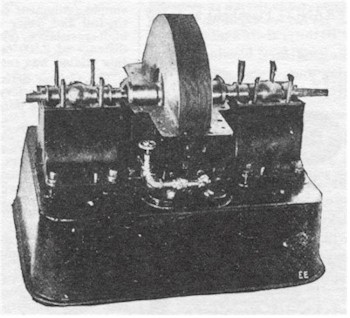
The Wonderful "Tesla" Steam Turbine; the Steam Flows Radially Up Between the Vanes, Not Against Them.
Many people are aware that a device such as a piston engine can reverse its role and act as a pump. This is the case with the Tesla turbine as well. In fact the design has already proven itself in a wide range of applications in the area of pump technology.
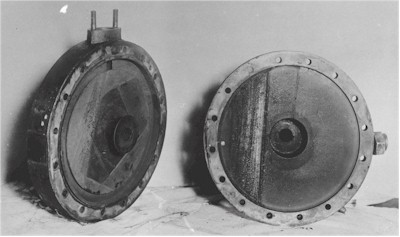
A Tesla turbo pump used in conjunction with a large Tesla turbine for speed regulation. [TTM009]
The pump's ability to handle corrosive materials is one design feature that will carry over into the turbine in that it will be able to operate for extended periods of time on corrosive fuels and propellants, such as gasoline, coal, gasified biomass and wet steam, that tend to damage certain internal components of conventional engines. The Tesla Disk Turbine would also be ideal for use with propane, natural gas or hydrogen as its fuel.
Nikola Tesla dreamt of a better world in which all work was performed in the most efficient and harmonious manner possible. AC power, radio communications, fluorescent lighting and some of the other technological innovations described above are familiar and vital components to life, which are serving to fulfill that vision. But Tesla developed many as yet unused inventions which have the capacity to be of an equivalent or perhaps even greater value to society. As the years went by it seems that Tesla began to accept the fact that circumstances would not allow for the immediate adoption of his more advanced ideas. With his passing on January 7, 1943 all opportunity to learn directly about those advanced technologies was lost. We are fortunate, however, to have inherited a large volume of material that relates directly to these designs. The primary source of knowledge is what might be called the Tesla canon. This includes his lectures and patents which have been published in book form. Additional sources are old newspapers and periodicals that reside in the archives of America's libraries and also the files of old legal firms that were active during his time. More information is to be found in Belgrade, Yugoslavia at the Muzej Nikole Tesle (Nikola Tesla Museum) that was established in the mid 1950s to hold artifacts and papers that were shipped there a few years after Tesla's death. In spite of the fact that some information appears to have been lost, the basic simplicity of the design principals involved assures their survival.
The Tesla Wardenclyffe Project and others now hope that the scientific and engineering communities at large can be persuaded to initiate dedicated research programs that will result in restoration of this vital knowledge. Such a thing can happen, but with the scant mention of Tesla's work in the curricula of our learning institutions this task may be difficult. There are things that can be done right away by schools, manufacturers, and the public at large that will speed up the reintegration process. Credit could be given where credit is due for the inventions that have long been incorporated into the very fabric of our daily lives. Also Tesla's less controversial designs, which have been made available but not widely utilized, could be developed and introduced into the public and private sectors.
Once our scientists and engineers are convinced of the overall validity of his designs through a practical hands-on understanding of them, then the work of bringing Tesla's entire vision closer to reality will accelerate.
All Rights Reserved, 1996-2005
Gary L. Peterson
glpeterson@teslascience.org